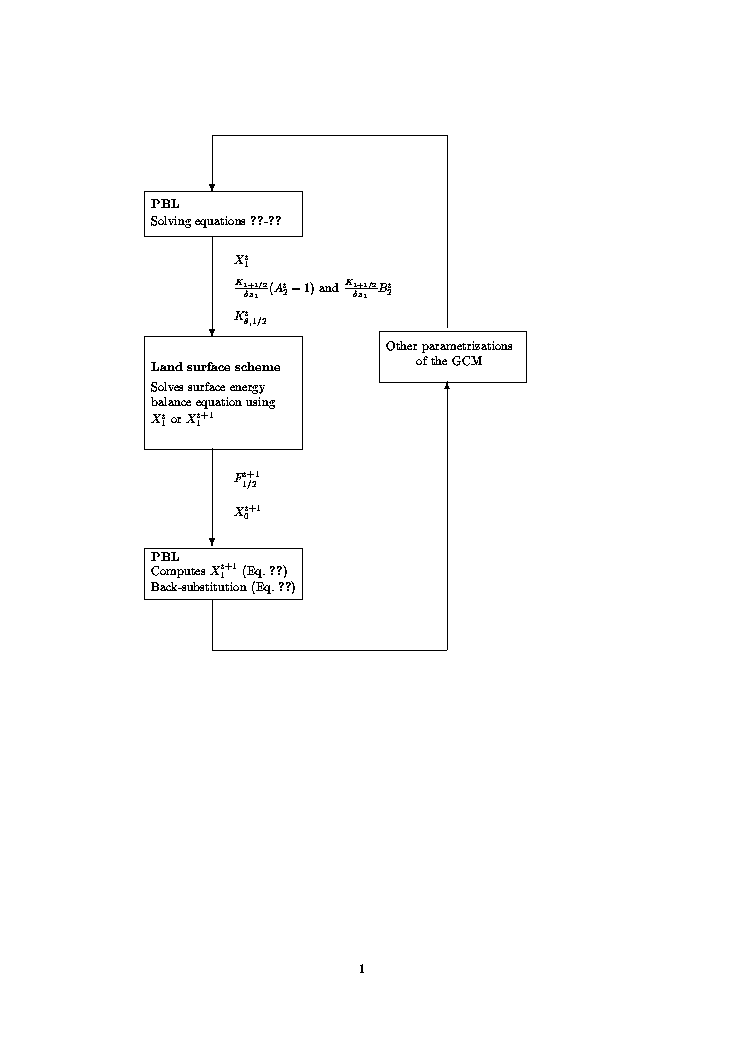After having defined the variables that need to be exchanged through the interface it needs to be determined where within the GCM the coupling has to occur. As the vertical diffusion has the strongest interaction with the LSS and also displays the largest diversity in numerical schemes, it will dictate the choice.
Depending on the type of coupling chosen for the vertical diffusion by the land surface scheme the atmospheric variables at the lowest atmospheric level are needed at time t or t+1. The only point where both of these values are available is within the resolution of the vertical diffusion after equations 17-19 have been solved and before the back-substitution is performed. It is at this point that the land surface scheme needs to be called.
If the land surface scheme is provided with the values for ![]() ,
,
![]() ,
, ![]() and
and ![]() it is able to compute
it is able to compute ![]() and
and ![]() from
equations 17-19 (X is either
from
equations 17-19 (X is either ![]() or
q, see Appendix A). This choice of variables allows the land-surface
scheme to use its own values for the surface drag by modifying
or
q, see Appendix A). This choice of variables allows the land-surface
scheme to use its own values for the surface drag by modifying
![]() . As pointed out in
section 2.4, this opens the door to problems of
consistency between the formulations used in the vertical diffusion
and the LSS.
. As pointed out in
section 2.4, this opens the door to problems of
consistency between the formulations used in the vertical diffusion
and the LSS.
With these arguments the land surface scheme obtains the variables at the lower atmospheric level and their sensitivity to changes in the surface conditions. This allows the surface scheme to compute, simultaneously with the surface conditions, the atmospheric variables at the lowest level for the new time step (Equation 16 is used for this step) as needed for the implicit coupling. The flow diagram of such a coupling scheme is given in Figure 1. Only one call to the land surface scheme is needed further facilitating the inclusion of many land surface schemes in a single GCM.

Figure 1: Flow diagram of the coupling scheme that
would allow the three types of closure of the vertical diffusion
equations to be used by land surface schemes. Only the variables
linked to the vertical diffusion are given here.
As there is only one call to the LSS the other variables of the interface have to be passed at this point as well. A list of the quantities which are inputs and outputs of the LSS are presented in tables 1 and 2. Whether the calls to radiation or the precipitation scheme are before or after the vertical diffusion and the LSS does not matter to the interface. This will only affect the choice of variables the GCM has to write to the restart files.

Table 1: Input to the land-surface scheme
![]()
Table 2: Output from the land-surface scheme
The practical issues of coupling two FORTRAN codes have not been dealt with in the present note. All the basic coding rules set-up by Kalnay et al. (1989) apply here as well but a few specific recommendation for LSSs can be made from the present discussion. Only one call needs to be made to the land-surface scheme within the GCM and this will be within the vertical diffusion scheme. A call to the initialization of the LSS will also be needed to set up the vegetation map, soil types and other internal parameters.
In order to simplify the coupling of the land-surface scheme it should have its own restart and history system. This avoids the problem of passing the prognostic variables of the LSS through the interface and having to handle them with the restart and history system of the GCM. Land-surface schemes are so different in their conception that they all have a different number of prognostic variables. Furthermore an independent restart and history facility has the advantage of making the LSS more independent of the GCM, simplifies its use in an off-line mode and allows for a different grid than the one of the GCM.
The LSS should be written in such a way that the GCM has control over which grid-points the LSS is going to perform the calculations on. This is an important aspect for running the model efficiently on parallel computers.
Developing the software to perform off-line experiments, as in PILPS phase 1 and 2, with land surface schemes which are coupled according to this interface will be a trivial exercise. This is a more practical advantage of this interface.